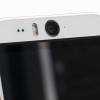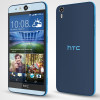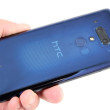Review: HTC Desire Eye for AT&T
Screen
The Desire Eye includes a 5.2-inch screen with 1920 x 1080 pixels (full HD), which is a good size/resolution for this class of device. It's a solid LCD panel. Everything on the screen is sharp. The screen produces more than enough light for easy indoor and outdoor viewing. Colors are rich and accurate. Viewing angles are decent. I didn't see any color shift when the phone was tilted side-to-side, but brightness dropped significantly. It's not as good as some other full HD screens I've seen, but it should be good enough for most people.
Signal
The Desire Eye performed just as well on AT&T's network as most other AT&T phones I've tested lately. The phone remained connected to AT&T's LTE network 99% of the time I used it. It dropped down to HSPA only once - and that was in a known poor coverage spot. I was always able to connect calls, and the Eye didn't drop any during testing. I did miss one call that went straight to voicemail. LTE data speeds were quite good. I never had a problem surfing the web, using Twitter, or downloading/installing apps. In short, you shouldn't have any problems with the network performance of the Desire Eye.
Sound
As for the quality of phone calls, I was pleased and I think you will be, too. Voices sounded crisp and clean coming through the speaker, if perhaps a little thin. Earpiece volume is good, but could be a little bit better. I would recommend you keep it set all the way up most of the time. This way you'll be able to carry a conversation when in moderately noisy spaces. If you're at a nightclub or another eardrum-crushing locale, don't expect to hear anything from the Eye's speaker. The people I spoke to when testing the Desire Eye said I sounded very good. Despite the presence of stereo BoomSound speakers, the speakerphone fell far short of my expectations as far as volume goes. It produces enough sound for your home or quiet office, but toss kids and a blaring TV into the mix and you'll need to find a quieter space. Volume aside, the quality of calls coming from the speakerphone was fantastic. The BoomSound speakers will scare you to death if you set the ringtone volume all the way up. Incoming calls sound like a siren going off in your living room. The vibrate alert is excellent, too.
Battery
The Desire Eye packs a 2,400 mAh power cell and I found it adequate in supplying about a day's worth of power. During the week I tested the phone it managed to retain a charge between 8am and midnight most days, though it fell short a couple of times. Using the camera extensively takes a bit of a toll on the Eye's battery life, but otherwise it matches what most other handsets deliver.
HTC's Sense user interface includes several tools for managing the battery. There's a simple Power Saver mode that covers basics, such as turning off WiFi and Bluetooth, and dimming the screen, to help eke out a few more hours of uptime. Extreme Power Saver kicks in when the phone hits 5% battery life (or 10%, or 20%, if you wish). It turns off almost all services except for text messages, phone calls, and manual email refresh. It even goes so far as to simplify the user interface. HTC didn't say how much time Extreme Power Saver mode buys the Desire Eye.


 Hands On with the HTC Desire EYE
Hands On with the HTC Desire EYE
 AT&T to Sell HTC Desire Eye and RE Camera Nov. 7
AT&T to Sell HTC Desire Eye and RE Camera Nov. 7
 HTC Desire EYE is a High-End Selfie Phone
HTC Desire EYE is a High-End Selfie Phone
 iPhone 15 Series Goes All-In on USB-C and Dynamic Island
iPhone 15 Series Goes All-In on USB-C and Dynamic Island
 HTC Desire EYE
HTC Desire EYE










